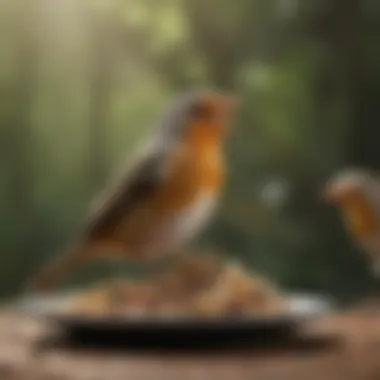Unveiling the Fascinating Dietary Patterns of Songbirds in Their Natural Habitats


Animal Species Profile
When delving into the dietary habits of songbirds, it is essential to first understand their animal species profile. Songbirds, characterized by their melodic tunes and colorful plumage, belong to the Passeriformes order. These avian creatures boast small to medium-sized bodies, with sharp, conical beaks suited for varied feeding habits. Their natural habitat spans across diverse ecosystems globally, including forests, meadows, and wetlands. In terms of behavior and social interactions, songbirds exhibit complex mating rituals, vocalizations for communication, and hierarchical structures within flocks.
Dietary Preferences and Foraging Behavior
Songbirds exhibit a fascinating array of dietary preferences and foraging behaviors, showcasing their adaptability in procuring nourishment. Their diets typically consist of a mix of seeds, insects, fruits, and nectar, varying based on species and seasonal availability. Foraging techniques range from ground feeding to aerial acrobatics, highlighting their agility and resourcefulness in securing food sources.
Nutritional Significance of Songbird Diets
Exploring the nutritional significance of songbird diets unveils the intricate balance of essential nutrients required for their sustenance and well-being. These avian creatures rely on protein-rich insects for growth and development, while seeds and fruits provide carbohydrates and essential fats. Additionally, the intake of calcium-rich sources is crucial for egg-laying females, emphasizing the specialized dietary needs for reproductive success.
Impact of Human Activities on Songbird Diets
The impact of human activities on songbird diets is a pressing concern in conservation efforts. Habitat destruction, pesticide use, and climate change pose significant threats to food availability for songbirds, disrupting their foraging patterns and overall nutrition. Understanding and mitigating these anthropogenic influences are paramount in safeguarding the dietary habits and ultimately, the survival of these iconic avian species.
Introduction
Overview of Songbirds
The Importance of Songbirds in Ecosystems
Songbirds play a pivotal role in maintaining ecological balance due to their contributions to seed dispersal, insect control, and pollination. Their melodious calls resonate through forests, signaling vitality and biodiversity. The persistence and adaptability of songbirds showcase nature's resilience, making them indispensable in preserving ecosystem health.
Characteristics of Songbirds
Songbirds possess distinct features such as colorful plumage, strong beaks for foraging, and superior vocal abilities. These characteristics not only distinguish them visually but also define their survival strategies. Their agility in flight and diverse behaviors highlight the evolutionary success of these avian wonders, emphasizing their significance in biological studies.
Significance of Understanding Songbirds' Diet
Impact of Diet on Songbirds' Health
The dietary choices of songbirds directly impact their reproductive success, immune function, and overall well-being. A nutritionally balanced diet ensures optimal growth and survival rates, reflecting the interconnectedness between food availability and avian health. By dissecting the impact of diet on songbirds' health, we unveil the essential link between nutrition, behavior, and population dynamics.
Ecological Connections through Diet


Songbirds act as ecological indicators, their dietary patterns reflecting habitat quality and ecosystem stability. By examining the intricate web of interactions between avian diets and environmental factors, we gain insights into broader ecological processes. Understanding the ecological connections through diet not only enriches our knowledge of songbird behaviors but also underscores the importance of conservation strategies for avian biodiversity.
Dietary Preferences of Songbirds
In the realm of avian dietary studies, delving into the dietary preferences of songbirds reveals a fascinating tapestry of food choices that these melodious creatures rely on for their sustenance and vitality. Understanding the dietary habits of songbirds not only provides insights into their ecological niche but also sheds light on the intricate balance required for their survival. Songbirds exhibit a diverse range of culinary inclinations, encompassing insects and invertebrates, seeds and grains, as well as fruits and berries. Each dietary preference plays a crucial role in the overall health and well-being of these feathered beauties, making it a compelling subject for scholarly exploration.
Types of Foods Consumed
Insects and Invertebrates
Exploring the consumption of insects and invertebrates among songbirds unravels a fundamental aspect of their dietary habits. These petite creatures serve as a vital source of protein and essential nutrients for songbirds, facilitating their growth and development. Insects and invertebrates stand out as a preferred choice due to their high nutritional value, offering a reliable energy boost for these aerial foragers. Their abundance in various ecosystems ensures a consistent food supply for songbirds, contributing significantly to their overall diet and health.
Seeds and Grains
Among the myriad of dietary options, seeds and grains emerge as staple choices for many songbird species. These plant-based foods provide a rich source of carbohydrates and essential nutrients, supporting the energetic demands of songbirds throughout different seasons. Seeds and grains are celebrated for their versatility and availability, making them a favorable choice for songbirds seeking sustenance in diverse habitats. While offering a valuable nutritional source, seeds and grains also play a pivotal role in ensuring the dietary diversity crucial for songbird populations.
Fruits and Berries
The consumption of fruits and berries adds a delectable dimension to the dietary preferences of songbirds, incorporating a burst of flavor and natural sweetness into their meals. Rich in vitamins, antioxidants, and fiber, fruits and berries offer an array of health benefits for songbirds, contributing to their overall well-being. These colorful and enticing food options strengthen the bond between songbirds and their environment, serving as a vital source of hydration and essential nutrients. The inclusion of fruits and berries in their diet showcases the adaptive nature of songbirds in exploring varied food sources to meet their nutritional requirements.
Factors Influencing Food Choices
Seasonal Variation
The impact of seasonal variation on the food choices of songbirds plays a significant role in shaping their dietary patterns. Fluctuations in food availability throughout different seasons lead songbirds to adjust their foraging strategies and dietary preferences accordingly. During the breeding season, songbirds may favor protein-rich foods to support growth and reproduction, while the winter months might see an emphasis on high-energy foods for thermoregulation. Seasonal variation influences the nutritional intake of songbirds, highlighting their adaptive abilities to thrive in dynamic environments.
Geographical Considerations
Geographical considerations intricately intertwine with the food choices of songbirds, reflecting the diverse habitats they inhabit across varying landscapes. The availability of specific food resources in different geographical regions significantly influences the dietary preferences of songbirds, shaping their foraging behaviors and nutritional requirements. Factors such as vegetation types, climate conditions, and ecosystem dynamics play a pivotal role in determining the food options accessible to songbirds. Understanding the geographical influences on food choices provides valuable insights into the adaptive strategies employed by songbirds to navigate their ever-changing environments.
Nutritional Significance of Songbirds' Diet
In this section of the article, we delve into the critical importance of understanding the nutritional significance of songbirds' diets. Songbirds, like all living beings, require specific nutrients to thrive in their natural environments. By exploring the protein and energy requirements, as well as the essential vitamins and minerals needed by songbirds, we can gain a deeper insight into how these avian creatures maintain their health, reproduction, and overall well-being.
Protein and Energy Requirements
Impact of Protein on Growth and Reproduction:


Protein plays a vital role in the growth and reproduction of songbirds. Adequate protein intake is essential for developing muscle mass, supporting feather health, and facilitating successful reproduction. Protein-rich diets are crucial for ensuring proper egg formation and chick development. Songbirds that have access to sufficient protein sources are more likely to exhibit robust growth rates and reproductive success. Additionally, protein aids in maintaining overall health and resilience against environmental stressors, making it a sought-after nutritional component in songbirds' diets.
Energy Demands for Migration:
Migration is a strenuous activity that requires significant energy expenditure. Songbirds undertake long migratory journeys, during which they need ample energy reserves to sustain them throughout the flight. Energy-dense foods are crucial for meeting the high metabolic demands associated with migration. By consuming foods rich in energy, such as fat-rich seeds and carbohydrates, songbirds can refuel during stopovers and complete their arduous journeys successfully. The ability to meet energy demands for migration directly impacts the survival and reproductive success of migratory songbirds.
Vitamins and Minerals
Role of Calcium in Egg Formation:
Calcium plays a crucial role in egg formation for female songbirds. Adequate calcium levels are necessary for producing strong and healthy eggshells. A calcium-deficient diet can lead to thin, brittle eggshells that are prone to breakage, jeopardizing the viability of embryos. Female songbirds must have access to calcium-rich foods, such as calcium-enriched insects or mineral deposits, to ensure successful reproduction. The role of calcium in egg formation underscores its significance in sustaining songbird populations and promoting reproductive success.
Importance of Vitamin for Overall Health:
Vitamin C is essential for maintaining the overall health and well-being of songbirds. As vital antioxidants, Vitamin C helps combat oxidative stress and strengthen the immune system. Songbirds rely on Vitamin C to ward off infections, promote healing, and support optimal physiological functions. A diet rich in Vitamin C-rich fruits and insects is crucial for songbirds to meet their daily requirements and stay healthy. The importance of Vitamin C in bolstering songbirds' immune responses and vitality underscores its significance in their diets.
Foraging Behavior of Songbirds
Strategies for Food Acquisition
Visual and Auditory Cues
Visual and auditory cues are pivotal components of songbirds' foraging behavior. These cues help them locate food sources and identify potential threats in their surroundings. Songbirds rely on sharp visual acuity to spot insects, seeds, or fruits amidst foliage. Additionally, their acute hearing aids in detecting subtle sounds indicative of food availability. Leveraging visual and auditory cues enables songbirds to optimize their foraging efforts, increasing their chances of securing nourishment.
Cooperative Foraging
Collaborative foraging is another fascinating aspect of songbirds' foraging behavior. Some species exhibit cooperative feeding habits, where individuals work together to obtain food efficiently. By foraging in groups, songbirds can cover more ground, share information about food locations, and enhance their overall foraging success. This cooperative behavior not only benefits individual birds but also fosters social bonds within songbird communities, contributing to their collective survival.
Adaptations for Efficient Feeding
Beak Morphology for Specific Diets
Beak morphology plays a crucial role in songbirds' feeding adaptations. Different beak shapes and sizes are tailored to specific dietary requirements. For instance, songbirds with slender, pointed beaks are adept at capturing insects, while those with robust, conical beaks excel at cracking seeds. The diverse beak structures reflect the specialized feeding niches that songbirds have evolved to occupy, showcasing the intricacies of their dietary preferences and foraging techniques.
Camouflage Techniques
Camouflage strategies are employed by songbirds to conceal themselves during feeding activities. By blending into their natural surroundings, songbirds minimize the risk of predation while foraging for food. Cryptic coloration, mimicry, and behavioral adaptations enhance their ability to remain undetected by predators. Camouflage techniques not only serve as a defense mechanism but also contribute to the evolutionary success of songbirds by ensuring their safety during critical feeding periods.


Human Impact on Songbirds' Food Sources
Human impact on songbirds' food sources is a critical topic of discussion in the article, shedding light on the multifaceted effects of human activities on the availability of food for these avian creatures. This issue resonates deeply in conservation efforts, emphasizing the need to address and mitigate the challenges faced by songbirds due to human-induced changes in their environment. Through an exploration of urbanization, habitat loss, and agricultural practices, the article aims to raise awareness about the pressing need to protect and preserve songbirds' food sources for the sake of biodiversity.
Urbanization and Habitat Loss
Urbanization and habitat loss pose significant threats to songbirds, affecting their food availability in profound ways. The effects of urban development on food availability can be detrimental, as natural habitats are cleared or disrupted to make way for infrastructure and human settlements. This alteration of landscapes directly impacts the abundance and diversity of food sources for songbirds, leading to challenges in foraging and overall survival. While urban areas may offer some supplemental food sources like bird feeders, these do not fully replace the complex array of natural foods that songbirds rely upon.
Mitigation Strategies for Human-Induced Challenges
To address the negative impacts of urbanization and habitat loss on songbirds' food sources, various mitigation strategies can be employed. These strategies focus on creating and preserving green spaces within urban environments, implementing bird-friendly landscaping practices, and educating the public about the importance of maintaining healthy ecosystems for wildlife. By enhancing habitat connectivity, reducing light pollution, and promoting native plant species, these strategies aim to mitigate the adverse effects of human-induced changes on songbirds' food availability and overall well-being.
Pesticides and Agricultural Practices
The use of pesticides and certain agricultural practices can have detrimental effects on songbirds, disrupting their food sources and exposing them to harmful chemicals. The impacts of pesticide contamination on songbirds extend beyond direct toxicity to affecting prey availability and ecosystem functions. Such contamination can lead to declines in insect populations, making it harder for songbirds to find adequate food supplies, especially during critical life stages such as breeding and molting.
Sustainable Farming Practices to Support Songbird Populations
In response to the challenges posed by pesticides and unsustainable agricultural methods, the adoption of sustainable farming practices emerges as a crucial solution to support songbird populations. Encouraging agroecological approaches, promoting integrated pest management, and maintaining wildlife corridors within agricultural landscapes are key strategies to ensure the availability of diverse and pesticide-free food sources for songbirds. By harmonizing agricultural practices with wildlife conservation, farmers can play a vital role in preserving songbirds' dietary habitats and promoting coexistence between agriculture and avian biodiversity.
Conclusion
In delving into the dietary habits of songbirds, the importance of the conclusion cannot be overstated. This final section serves as a culmination of the in-depth exploration into the dietary preferences, nutritional significance, foraging behavior, and human impact on songbirds' food sources. Through synthesizing the information presented throughout the article, readers can grasp the intricate relationship between songbirds and their food sources. Understanding the dietary habits of songbirds is crucial for promoting biodiversity, enhancing conservation efforts, and fostering a deeper connection with nature.
Enhancing Conservation Efforts
Promoting Biodiversity in Urban Environments
One crucial aspect of enhancing conservation efforts is promoting biodiversity in urban environments. Urban areas often pose challenges for songbirds due to habitat loss and fragmentation. By promoting biodiversity through the preservation and creation of green spaces, urban planners and communities can provide vital habitats for songbirds. The key characteristic of promoting biodiversity in urban environments lies in creating a conducive environment for diverse plant and animal species to thrive. This approach is a popular choice for conservationists as it not only benefits songbirds but also contributes to overall ecosystem health. The unique feature of promoting biodiversity in urban environments is its ability to support a wide range of wildlife, including songbirds, thus creating resilient and sustainable urban ecosystems.
Educational Initiatives for Bird-Friendly Landscaping
Educational initiatives focusing on bird-friendly landscaping play a crucial role in enhancing conservation efforts. By educating the public about the importance of providing suitable habitats for songbirds, these initiatives raise awareness and promote positive actions. The key characteristic of educational initiatives for bird-friendly landscaping is empowering individuals to make informed decisions on landscaping practices that benefit songbirds. This approach is a beneficial choice for the article as it promotes community involvement and fosters a sense of stewardship towards wildlife. A unique feature of educational initiatives is their potential to reach a wide audience and instill a culture of bird-friendly practices, ultimately creating a supportive environment for songbirds to thrive.
Future Research Directions
Exploring Climate Change Impacts on Songbirds' Food Sources
Exploring climate change impacts on songbirds' food sources is a critical area for future research. Climate change can alter the availability and quality of food sources for songbirds, impacting their populations and ecosystems. The key characteristic of this research direction is its potential to uncover the specific ways in which climate change influences the food sources of songbirds. This topic is a beneficial choice for the article as it addresses pressing environmental concerns and highlights the need for adaptive conservation strategies. A unique feature of exploring climate change impacts is the opportunity to develop proactive measures to mitigate the impact of climate change on songbirds and their food sources.
Innovations in Sustainable Bird Feeding Practices
Innovations in sustainable bird feeding practices offer promising avenues for supporting songbird populations. By developing sustainable feeding practices, researchers and conservationists can minimize negative impacts on songbirds while ensuring their nutritional needs are met. The key characteristic of these innovations is their focus on balancing human interactions with songbirds in a way that sustains their populations and habitats. This choice is beneficial for the article as it emphasizes the importance of responsible bird feeding practices and encourages environmentally friendly approaches. A unique feature of sustainable bird feeding practices is their potential to engage communities in bird conservation efforts and promote harmonious coexistence between humans and songbirds.







